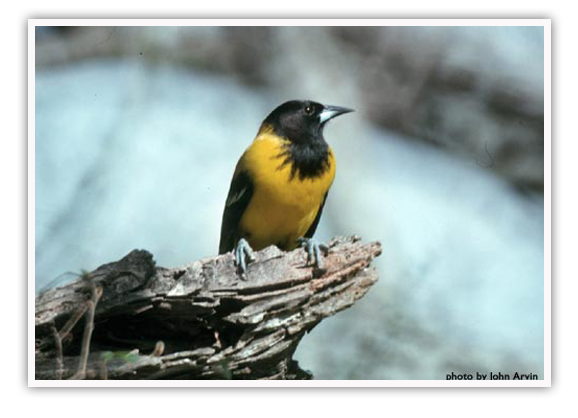Bird Info
Audubon's Oriole /bolsero cabeza negra (Icturus graduacauda)
Voice: Call is a harsh“ike-ike-ike….,” similar to that of Altamira Oriole but slightly softer. Song is a slightly off-key series of whistles “hoooooo, heeeowee, heeooo, heweee……”

Status: Locally uncommon resident along the Rio Grande from Roma to Falcon Dam; also found in brush country of Starr County and Kenedy County ranches (King, Kenedy, and Armstrong Ranches) just north of the Valley.
Habitat: Riparian woods of the Rio Grande corridor, brushy thickets, and live-oak woodlands (north of the Valley).
Best Spots: Rio Grande woodlands from World Birding Center’s Roma Bluffs to woodlands below Falcon Dam, including feeding stations at Salineño and Chapeño.
Similar Species: There is no other black-headed, yellow oriole in range (Scott’s Oriole occurs further west).
All Bird call recordings © John C. Arvin.
Rare Bird Alert
Call (956) 584-2731 to hear or submit an alert.
Nine Unique Locations
- Bentsen-Rio Grande (Mission)
- Edinburg Scenic Wetlands
- Estero Llano Grande (Weslaco)
- Harlingen Arroyo Colorado
- Old Hidalgo Pumphouse
- Quinta Mazatlan (McAllen)
- Resaca de la Palma (Brownsville)
- Roma Bluffs
- South Padre Island Birding
and Nature Center
Birds News
A Birder's Eye View of the Seasons in the
Lower Rio Grande Valley
Welcome to a birder’s eye view of the seasons in the Lower Rio Grande Valley. Enjoy our annual cycle! The resulting avifauna in deep South Texas is the most diverse north of the Mexican border. The four county area that makes up the lower Rio Grande Valley has recorded over 500 species of birds. This is more species of birds than have been recorded in all but two or three entire states. Small wonder that birders from across the continent make pilgrimages to the region. Happy Birding!
Welcome to a birder’s eye view of the seasons in the Lower Rio Grande Valley. Enjoy our annual cycle! The resulting avifauna in deep South Texas is the most diverse north of the Mexican border. The four county area that makes up the lower Rio Grande Valley has recorded over 500 species of birds. This is more species of birds than have been recorded in all but two or three entire states. Small wonder that birders from across the continent make pilgrimages to the region. Happy Birding!
Birds Check List
What is a checklist?
A "Bird Checklist" is a complete list of birds that have been seen or heard in a specific region like Texas or the Rio Grande Valley. Checklists can be used as a personal diary of your travels.
Checklists by site:
A "Bird Checklist" is a complete list of birds that have been seen or heard in a specific region like Texas or the Rio Grande Valley. Checklists can be used as a personal diary of your travels.
These require Adobe Acrobat to view.
Get Adobe Acrobat Reader
Checklists by site: